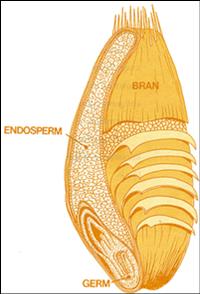There is much to do about whole grains as a health food. Healthy diets extol the benefits of whole grain cereals and pastas made from whole grain; yet astonishingly, a lot of people only have a vague idea what whole grains actually are. Let us get to know a little more about whole grains and get to the bottom of what the hullabaloo is about.
The Anatomy of a Grain
Whole grains means exactly what they are…solid grains with three important parts intact: the bran, the endosperm, and the germ. Whole grain examples include brown rice, rye, barley, and wheat.

Image from:Anatomy of a Whole Grain
The outermost skin of the grain is the bran which comes in many layers. The bran forms the fibrous part of the food and is packed with fiber, starch, protein, B vitamins, and minerals such as iron, copper, zinc, and magnesium. Inside the grain, a large portion of the space is made of the endosperm. The endosperm carries the bulk of the carbohydrate content and protein, but is low in nutrients. The germ is the grain’s inner sanctum that houses the phytochemicals, Vitamin E, Vitamin B, and some antioxidants.
Whole grains may be served as a solid whole, milled, crushed, cracked, cooked, extruded, or rolled. In order for a food to be qualified as a whole grain, however, it must meet the definition set by the Whole Grains Council in 2004:
“Whole grains or foods made from them contain all the essential parts and naturally-occurring nutrients of the entire grain seed in their original proportions. If the grain has been processed (e.g., cracked, crushed, rolled, extruded, and/or cooked), the food product should deliver the same rich balance of nutrients that are found in the original grain seed.”
In other words, whatever processing the grains have undergone, it should still have all of its important parts—bran, endosperm, and germ—present in the food. This means genuine whole wheat breads should consist of wheat with 100% of its original materials present.
What is so important about maintaining all those whole grain parts intact?
Each whole grain is a little powerhouse of health-sustaining nutrients. Stripping any of these parts away would throw out those rich nutrients that are distributed within the parts. Refining is a stripping process that does just this. When grains are refined, most of the bran and the germ are taken away, leaving the endosperm to form the bulk of the processed food. The stripped down food versions are our white rice, white bread, white flour (enriched wheat also falls in this category), and white pasta. Refined food does not offer much, if any, of the vitamins, fiber, antioxidants, and minerals that whole grain types do.
The carbohydrates in refined grains are digested by our body as simple sugars. These sugars are what frequently cause blood sugar levels to spike and crash suddenly, leaving your metabolism in a constant harried state of trying to keep up. Often, these spikes leave us exhausted and irritable. On the other hand, whole grain food does not demand a sudden insulin increase so that your energy and your metabolic state are on an even keel for long hours. That is why we need quality carbohydrates from whole grains, fruits, vegetables, and other high energy foods that don’t stress our pancreas.
The Gains from the Grain
The Australian Dietary Guidelines and the New Zealand Food and Nutrition Guidelines agree that we need about 6 servings of whole grain food daily. What’s a serving? A serving could consist of ½ cup of muesli, 1 wholegrain muffin, 1 wholegrain roll, or ½ cup cooked oats.
Although life offers no guarantees, reducing your health risks is certainly worth the effort. Incorporating whole grains into your diet could net you the following benefits:
- Help you with weight loss or weight maintenance – The high fiber content fills you up and staves of hunger pangs longer. Better quality carbohydrates in whole grains do not mess with your metabolic functions so your cravings are controlled as well.
- Protect against cardiovascular disease and stroke – Whole grains help lower cholesterol and blood pressure.
- Generally ups your odds for living longer – A 25-year study found that people who ingested at least 28 grams of whole grains daily increased their chances for living longer lives.
- Significantly reduce your risk for developing Type 2 diabetes – Two servings of wholegrain foods a day can reduce diabetes risks by 21 percent.
- Lower your risk for bowel cancer – The fibrous nature of whole grains engender bulkier stools and better bowel actions.
Is that Whole Grain Product the Real Deal?
Food marketing is tricky and many times employ confusing terms to indicate healthy choices where there are actually none. To make sure the loaf or muffin you are eyeing is a whole grain product, pay attention to the labels.
A label emblazoned with “multi-grain” or “all-bran” may not necessarily mean that the food on offer is largely made up of whole grains. For one, “all-bran” means just that—the product is not whole grain because you only get the bran, not the other parts of the grain. “Multi-grain” may mean the loaf is probably made up of 7 grains, some of which have been refined of its germ or bran.
The ingredients list is the most important part of the label and this is where you should scrutinize well.
The first and second ingredients are understood to form the bulk of the food. These should then have the term “whole” before the grain it describes. Examples: whole wheat, whole grain rye, etc.
If the first ingredient reads “enriched wheat flour,” know that this means refined flour.
Be wary of marketing terms. Get the habit of reading the fine print (ingredients list) to know what you are actually feeding yourself and your family.